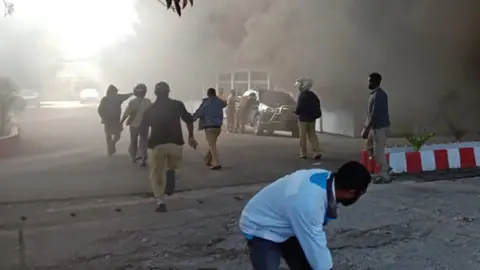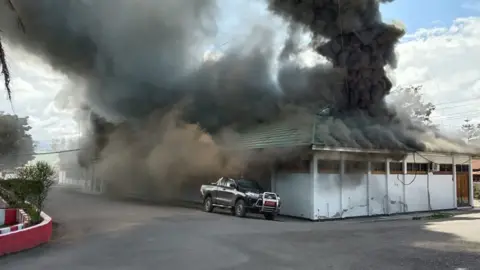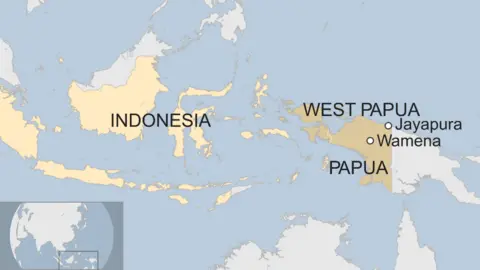West Papua: Day of violence sees at least 27 dead
 Getty Images
Getty ImagesA new wave of violence has hit the restive Indonesian region of West Papua after hundreds of protesters, mostly high school students, set fire to several buildings in a town on Monday.
At least 23 people died in the regional capital Wamena, some of whom were trapped inside burning buildings.
The protests were reportedly triggered by a teacher's racist comments - an allegation the police called a "hoax".
It's the latest violence in the region, which saw weeks of unrest in August.
The number of killed is expected to rise as the search for victims continues on Tuesday.
Four people died in a separate incident in the provincial capital of Jayapura, bringing the death toll to 27.
The incident in Jayapura took place after a mob of students reportedly attacked a soldier and police officers with machetes and rocks.
 Getty Images
Getty ImagesThe day of violence came after a period of relative calm in the region, which last month was rocked by mass demonstrations in response to claims of racism.
The previous protests stemmed from an incident where nationalist groups accused Papuan university students in Surabaya of damaging an Indonesian flag during Independence Day celebrations.
The groups had goaded the students, calling them "monkeys", "pigs" and "dogs".
What happened on Monday?
On Monday, two separate attacks took place across Wamena and Jayapura in Papua.
The violence in Wamena was triggered by racist slurs directed at students by a teacher, said a spokesman for a West Papua separatist group.
However, Papua police denied this, calling it a "hoax". They said clashes broke out after a fight between students from different schools.
Papua military spokesman Eko Daryanto told news agency AFP the death toll from Monday's violence could rise, saying many civilians had been "trapped in burning kiosks".
Local military commander Chandra Dianto told the news agency that other victims were "burned... some were hacked to death".
Some 700 people were brought in for questioning by police but most were released.
Meanwhile in Jayapura, clashes took place between security forces and protesters, with pictures showing scores of police gathered outside a university.
 Getty Images
Getty ImagesMr Daryanto told news agency the Associated Press that a mob of students had attacked a soldier and police officers in Jayapura with machetes and rocks.
Security forces responded with gunfire, killing three civilians, he told AP. The soldier later died.
Why is there violence in West Papua?
It was the taunting of the Papua students that triggered the violence earlier this year, but for many in the region, feelings of resentment towards Indonesia have been simmering for decades.
The former Dutch colony did not become part of Indonesia until 1963, after a short period under UN control.
A referendum on its independence was held in 1969 but only about 1,000 people were allowed to vote.
As a result, a low-level separatist movement, fighting for independence, continues to this day.
The Indonesian military, meanwhile, is accused of gross human rights abuses in their attempt to suppress any form of dissent in the province.
Analysis
By Jonathan Head, BBC South East Asia correspondent
When the 32-year rule of President Suharto came crashing down in Indonesia 21 years ago, there were real fears the country would break up - an Asian Yugoslavia.
Aside from the former Portuguese territory of East Timor, that did not happen, thanks in part to a new democracy, decentralisation and, in some regions, autonomy.
But the eastern region of Papua remains troubled, and much of its indigenous population unreconciled to Indonesian rule.
"Indonesia is either the former Dutch East Indies or it is nothing," I was told by one government adviser in the perilous days following Suharto's fall. But Papua is a special case.
It was not incorporated into Indonesia in the decolonisation agreement with the Netherlands in 1949. It was handed over only in 1963, to be approved by a referendum in 1969, the so-called "Act of Free Choice", widely accepted now as an Indonesian-manipulated sham.
Remote, undeveloped and largely ignored by the world, Papua's rich resources were crudely exploited by Indonesia, a pro-independence movement was harshly suppressed, and waves of migrants encouraged to move there from other islands.
Papua has enjoyed a form of autonomy since 2001, with other attempts made by successive Indonesian governments to assuage local resentment. But hostility to Indonesian rule runs deep.
Where is West Papua?
Papua is divided into two provinces, Papua and West Papua - the two regions are collectively referred to as West Papua.
Together, they make up the western half of the island of New Guinea. The eastern half of the island is comprised of the independent state of Papua New Guinea.

